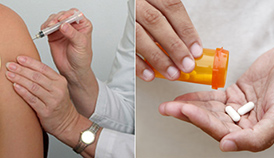Office of Research & Development |
 |

VA Research Currents archive
September 29, 2016

A VA study compared costs between a long-acting injectable drug and daily or twice-daily tablets for treating schizophrenia. (Photo left: CDC; right: ©iStock/Ivan Bajic)
Schizophrenia is a common but expensive illness to treat, with annual cost estimates nationwide at $30,000 per patient. The brain disorder can be chronic and severe, affecting the way a person thinks, feels, and acts—and can even be associated with higher rates of death by suicide. Veterans with schizophrenia occupy more hospital beds than Vets with any other illness.
The causes of schizophrenia are unknown, so treatments focus on managing symptoms of the disease, often using antipsychotic medications that are administered orally or by injection. Nonadherence to oral drugs, usually taken in pill form once or twice a day, can undermine the effectiveness of treatment. Injectable antipsychotics, commonly administered once a month by a health professional, may improve adherence.
"In this case, it looks like spending more on pharmacy and outpatient visits saves money on inpatient admissions and results in a lower total cost."
A VA database study published recently in The Journal of Clinical Psychiatry compared cost factors involving Veterans with schizophrenia who use paliperidone palmitate (PP), a long-acting injectable antipsychotic, versus oral atypical antipsychotics. The study found that those treated with paliperidone palmitate, which was approved by the FDA in 2009, incurred significantly lower health care costs than those who consumed oral antipsychotics, although paliperidone palmitate is much more expensive.
According to the results, the average annual pharmacy ($3,417) and outpatient ($2,527) costs for users of paliperidone palmitate were higher, but the average annual inpatient costs ($14,456) were lower, resulting in an average annual cost-savings of $8,511, compared with oral antipsychotics.
Researchers attributed the total savings to the lower likelihood of inpatient hospitalizations for users of paliperidone palmitate.
"In this case, it looks like spending more on pharmacy and outpatient visits saves money on inpatient admissions and results in a lower total cost," says study co-author Dr. Brian Shiner, a psychiatrist at the VA Medical Center in White River Junction, Vermont. "If each of those three cost centers tried to minimize cost without being aware of the overall process, we might end up with sub-optimization. In other words, attempts to minimize costs in pharmacy and outpatient visits might result in worse outcomes and higher overall costs."
Shiner adds, "Hospitalization is often used as a marker of unsuccessful outpatient management, so having fewer hospitalizations is generally seen as a good thing."
The study was funded in part by Janssen Scientific Affairs, LLC, whose sister company, Janssen Research and Development, LLC, makes paliperidone palmitate. But the research was conducted independently by experts with White River Junction's Clinical Epidemiology Research Group and by the Analysis Group, a private firm in Boston.
In addition to comparing the economic impact of an injectable antipsychotic with that of oral medications, the researchers studied the benefit of using paliperidone palmitate as part of VA's Mental Health Intensive Case Management (MHICM) program. The program assists Veterans with serious mental illnesses—including psychotic disorders such as schizophrenia, schizoaffective disorder, and bipolar disorder—in their homes and communities. The program operates at around 100 sites nationwide.
The final analysis shows that paliperidone palmitate patients in the case-management program realized a cost-savings of $22,584, much more than patients on that drug not in the program ($5,221) and the total sample in the study ($8,511).
"Decreasing hospitalization and improving functioning in the community are some of the big goals of assertive community treatment programs like MHICM, so it was really important for us to attempt to tease the effects of paliperidone palmitate and MHICM apart," Shiner says. "There may be some synergy for using long-acting injectable drugs like paliperidone palmitate and participating in the MICHM program."
It's possible, Shiner says, that professionals in that program were proficient at organizing themselves around patients who started using paliperidone palmitate. "Perhaps MHICM teams are just better designed and resourced to do this kind of thing than clinicians working more independently," he says.
The researchers used VA electronic health record data for 2,285 Veterans who started using paliperidone palmitate and 8,005 who initiated oral atypical antipsychotics between January 2010 and October 2014. The study population included Veterans who had at least two schizophrenia diagnoses during the observation period, and at least two doses of paliperidone palmitate or oral antipsychotics within 90 days during the observation period.
The study found not only that paliperidone palmitate was associated with less frequent in-patient hospitalizations and more frequent visits involving the Mental Health Intensive Case Management program, but also that its users had higher socioeconomic status.
The researchers, however, are uncertain why users of paliperidone palmitate are less likely to need inpatient hospital visits compared with patients on oral drugs.
"One hopeful possibility is that patients on paliperidone palmitate are better able to engage in their outpatient care, manage their disease, and stay healthy enough to remain in the community," Shiner says. "Another possibility that we can't rule out is that patients who are better able to engage in their outpatient care, manage their disease, and stay healthy enough to remain in the community are also more likely to receive paliperidone palmitate."
While the study looked at only paliperidone palmitate because the research was funded by the maker of that drug, Shiner notes that other long-acting injectable antipsychotics may offer similar benefits.
"There is more room for research both on other individual long-acting injectable antipsychotic medications and for using retrospective methods to compare outcomes among individual agents," he says. "As far as whether more patients will be treated with paliperidone palmitate or any other treatment for that matter, it should depend on how many appropriate and well-informed patients decide with their clinician that it is the best choice for them. This is one study and clinicians should take it in the context of other research on long-acting injectable antipsychotics, including both other large retrospective studies and prospective [randomized controlled trials]."